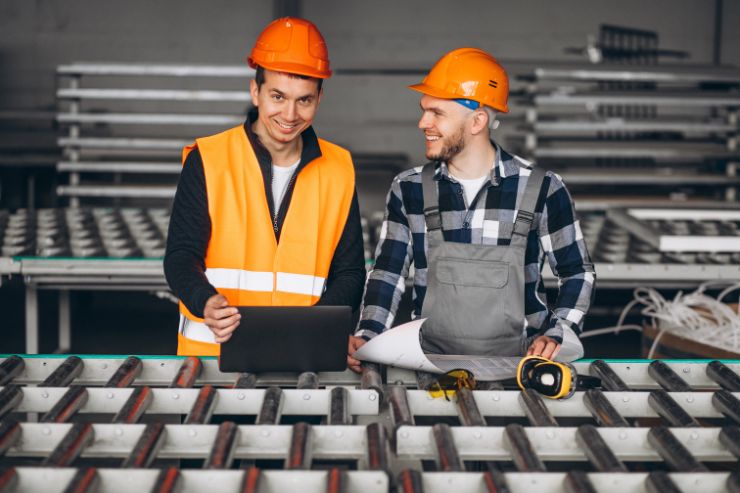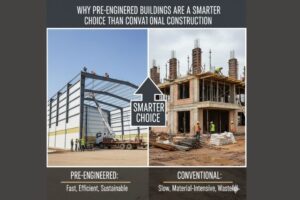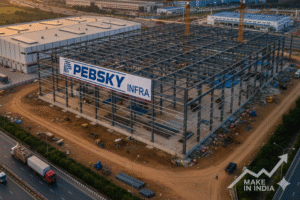When planning a construction project, especially in industrial, commercial, or warehousing sectors, Pre Engineered Buildings (PEBs) have become the go-to solution. They are cost-effective, quick to erect, durable, and customizable to fit a variety of needs. However, the success of your project largely depends on choosing the right pre engineered building manufacturer.
With so many pre engineered building manufacturers in India, making the right choice can be overwhelming. In this blog, we will guide you through the key factors to consider when selecting the best PEB manufacturer for your project.
Table of Contents
ToggleWhat Are Pre Engineered Buildings?
Pre Engineered Buildings are structures built using prefabricated steel components that are manufactured in a factory and assembled on-site. Unlike conventional construction, PEBs are designed and manufactured to exact specifications using advanced software and machinery, ensuring precision and quality.
Key Features of PEBs:
- Lightweight yet strong
- Fast construction time
- Cost-effective
- Low maintenance
- Energy efficient
- Customizable design
Given these benefits, choosing the right manufacturer becomes a critical decision for the quality and longevity of your building.
Why Choosing the Right PEB Manufacturer Matters
Your PEB manufacturer will be responsible for:
- Designing the building structure
- Fabricating steel components
- Ensuring structural integrity
- Adhering to project timelines
- Providing technical and after-sales support
A wrong choice could lead to delays, cost overruns, safety concerns, and long-term maintenance issues.
How to Choose the Right Pre Engineered Building Manufacturer
Here’s a more detailed breakdown of factors to consider:
1. Experience and Reputation
One of the first aspects to evaluate is the manufacturer’s experience and reputation in the industry.
Track Record
Choose a company that has a solid history of successfully completed projects. Manufacturers with a long-standing presence in the industry are more likely to offer reliable and quality services. Look for:
- Past projects similar to yours
- Years of experience in the PEB industry
- Repeat clients or long-term partnerships
Client Reviews and Testimonials
Check their website, Google reviews, and industry forums for testimonials and feedback. Positive client experiences are a good indicator of professionalism, timely delivery, and product quality.
References
Ask the manufacturer to provide references. Speaking directly to past clients can give you an honest insight into the company’s reliability and performance.
2. Design Capabilities and Customization
The ability to offer tailored design solutions is a major differentiator among PEB manufacturers.
Custom Solutions
Your project will have unique requirements. Choose a manufacturer that can offer flexible solutions, including specific dimensions, layouts, insulation needs, and other functional requirements.
Use of Advanced Design Software
Top manufacturers use advanced software such as:
- STAAD.Pro
- Tekla Structures
- ETABS
These tools ensure precise, safe, and code-compliant designs.
In-House Engineering Team
An experienced team of structural engineers can provide custom drawings, perform feasibility studies, and ensure the design complies with local regulations and environmental conditions.
3. Quality of Materials and Manufacturing Capabilities
The durability and safety of your building are directly tied to the quality of materials and the manufacturing process.
Certified Materials
Ensure that the manufacturer uses high-grade steel and other certified materials. Look for compliance with:
- IS codes (Indian Standards)
- ASTM or British Standards (for international quality benchmarks)
State-of-the-Art Manufacturing Facilities
If possible, visit the manufacturing plant. Assess their machinery, fabrication lines, and quality control measures. This visit will give you an idea of how streamlined and efficient their operations are.
In-House Fabrication and Assembly
Choose manufacturers that handle most of the process in-house rather than outsourcing. This ensures better control over quality and timelines.
Project Management and Support Services
An ideal PEB manufacturer is not just a supplier but a partner throughout your project lifecycle.
Dedicated Project Managers
Efficient project managers help streamline timelines, reduce errors, and coordinate smoothly with architects, contractors, and consultants.
On-Time Delivery
Ask about their average lead time and whether they meet their project deadlines consistently. Delays can lead to cost overruns and contractual issues.
After-Sales Support
After-sales service is a sign of a reliable manufacturer. It should include:
- Warranty support
- Maintenance guidance
- Repair and upgrade services
5. Pricing and Value for Money
While price is important, it should never be the sole deciding factor when choosing a pre engineered building manufacturer.
Transparent Pricing
Get detailed quotations from multiple vendors. Compare inclusions like materials, labor, erection services, and taxes.
Long-Term Value
Assess the durability, efficiency, and future scalability of their solutions. A slightly higher upfront investment in quality can save you money in maintenance and operational costs later.
6. Compliance with Building Codes and Certifications
Pre engineered building manufacturers in India must follow specific local and international standards.
Local Compliance
Ensure the manufacturer is well-versed in state and city-level building codes. This includes seismic zone considerations, wind load calculations, fire safety norms, and more.
Industry Certifications
Look for the following certifications:
- ISO 9001 – Quality Management
- ISO 14001 – Environmental Management
- OHSAS 18001 – Occupational Health and Safety
- CE Certification (for European exports)
These certifications are markers of a company’s commitment to quality, safety, and environmental responsibility.
7. Geographic Reach and Logistics
Manufacturers with a strong pan-India presence are better positioned to serve you quickly and efficiently.
Logistics Network
Check whether they have a reliable transportation network to deliver materials to your site on time and in good condition.
Local Support Teams
Having local teams or service partners can help you get quicker support during installation or if post-installation issues arise.
8. Innovation and Sustainability
Top PEB manufacturers are now incorporating eco-friendly practices and smart technology into their building solutions.
Green Building Practices
Ask if the manufacturer offers:
- Recyclable steel
- Energy-efficient insulation options
- Solar panel integration
BIM Integration
Some manufacturers offer Building Information Modeling (BIM) services for better visualization, planning, and clash detection.
Conclusion
Selecting the right pre engineered building manufacturer is one of the most crucial steps for your construction project. By evaluating experience, manufacturing capabilities, design expertise, quality standards, and support services, you can ensure that your project is in the right hands.
With the growing demand for steel structures across sectors, many pre engineered building manufacturers in Ghaziabad India now offer turnkey solutions that combine engineering excellence with cost efficiency. Take the time to research and partner with a company that understands your vision and can deliver a structure that stands strong for decades.
Frequently Asked Questions
1. Who is the best pre-engineered metal building manufacturer?
There are several top PEB manufacturers in India, including Tata BlueScope, Kirby Building Systems, and Zamil Steel. The best choice depends on your project size, location, and specific requirements.
2. What are the benefits of PEB?
PEBs offer faster construction, cost savings, durability, low maintenance, and design flexibility.
3. What are the main components of a PEB structure?
The key components include the primary framing system (columns and rafters), secondary framing (purlins, girts), roof and wall panels, bracing systems, and fasteners.
4. What is the life of a PEB building?
With proper maintenance, PEB structures can last 30 to 50 years or more.
5. What are the 3 types of buildings?
The three main types are residential, commercial, and industrial buildings.
6. How to design a PEB building?
PEB Design involves calculating loads, selecting suitable framing systems, detailing connections, and using structural software like STAAD Pro or Tekla.
7. What materials are used in PEB?
PEBs mainly use high-strength steel, galvanized sheets, insulation materials, and sometimes aluminum or sandwich panels for roofing and walls.






